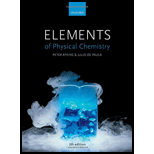
(a)
Interpretation:
The vapor pressure of water at
Concept Introduction:
Vapor pressure:
Vapor pressure can be defined as the pressure exerted by the vapor when it is in
Enthalpy of vaporization:
Enthalpy of vaporization is defined as the amount of heat that has to be transferred to a liquid so that it can be transformed to its vapor phase. It is dependent on pressure.
Clausius-Clapeyron equation:
This equation is used to calculate the vapor pressure at different temperature if pressure at one temperature and enthalpy of vaporization are known.
Where,
(a)
Answer to Problem 4.1PR
Pressure at
Explanation of Solution
According to Clausius-Clapeyron equation,
Given that,
It is also given that
At boiling temperature of water the pressure is
The another temperature at which vapor pressure has to calculated is given as
The pressure to be calculated is
Applying Clausius-Clapeyron equation,
Hence the pressure at
(b)
Interpretation:
Derivation for the modified version of Clausius-Clapeyron equation has to be done in the given condition of
Concept Introduction:
Vapor pressure:
Vapor pressure can be defined as the pressure exerted by the vapor when it is in thermodynamic equilibrium with its liquid or condensed phase at a given temperature in a closed system. It relates to the tendency of a particle to escape from its liquid phase. High vapor pressure at normal temperature is referred to as volatile. With increase in temperature the vapor pressure increases.
Enthalpy of vaporization:
Enthalpy of vaporization is defined as the amount of heat that has to be transferred to a liquid so that it can be transformed to its vapor phase. It is dependent on pressure.
Clausius-Clapeyron equation:
This equation is used to calculate the vapor pressure at different temperature if pressure at one temperature and enthalpy of vaporization are known.
Where,
(b)
Explanation of Solution
According to Clausius-Clapeyron equation,
It is given that
Using the method of calculus on Clausius-Clapeyron equation we get,
Thus the modified version of Clausius-Clapeyron equation when
(c)
Interpretation:
With the help of modified version of Clausius-Clapeyron equation, vapor pressure of water at
Concept Introduction:
Vapor pressure:
Vapor pressure can be defined as the pressure exerted by the vapor when it is in thermodynamic equilibrium with its liquid or condensed phase at a given temperature in a closed system. It relates to the tendency of a particle to escape from its liquid phase. High vapor pressure at normal temperature is referred to as volatile. With increase in temperature the vapor pressure increases.
Enthalpy of vaporization:
Enthalpy of vaporization is defined as the amount of heat that has to be transferred to a liquid so that it can be transformed to its vapor phase. It is dependent on pressure.
Clausius-Clapeyron equation:
This equation is used to calculate the vapor pressure at different temperature if pressure at one temperature and enthalpy of vaporization are known.
Where,
(c)
Answer to Problem 4.1PR
Vapor pressure calculated at
Explanation of Solution
According to Clausius-Clapeyron equation,
According to modified version of Clausius-Clapeyron equation when
At boiling temperature of water the pressure is
The another temperature at which vapor pressure has to calculated is given as
The pressure to be calculated is
Applying Clausius-Clapeyron equation,
With the help of the modified Clausius-Clapeyron equation the vapor pressure calculated at
Want to see more full solutions like this?
Chapter 4 Solutions
Elements Of Physical Chemistry
- please provide the structure for this problem, thank you!arrow_forwardDraw the Fischer projection from the skeletal structure shown below. HO OH OH OH OH H Q Drawing Atoms, Bonds and Rings Charges I ☐ T HO H H OH HO I CH2OH H OH Drag H OH -CH2OH CHO -COOH Undo Reset Remove Donearrow_forwardplease provide the structure for this problem, thank youarrow_forward
- presented by Morallen Lig Intermine the hand product for the given mution by adding atoms, bonds, nonhonding diarion panda скуль Step 3: Comp the draw the product Step 2: Agama workup Compithe 429 ملولةarrow_forwardReaction A 0,0arrow_forwardpresented by Morillon Leaning Predict the organic product for the min кусур HSC Adithane carved arnown to come than that to the condon slchroruis in acid in in aquishri with ноюarrow_forward
- 6.15PM Sun Mar 30 K Draw the major product of this reaction. Include any relevant stereochemistry. Ignore inorganic byproducts. Problem 1 of O H [PhзPCH2CH3]*C|¯ NaH Drawing > Q Atoms, Bonds and Draw or tap a nearrow_forward8:17 PM Sun Mar 30 Draw the major product of this reaction. Ignore inorganic byproducts. HSCH2CH2CH2SH, BF3 Probler Drawing Ato Bonds Clarrow_forwardpresented by Mr L How the coprion. (Il Done in no wraction, dew the starting redential) доarrow_forward
- 8:16 PM Sun Mar 30 K Draw the major product of this reaction. Ignore inorganic byproducts. Proble 1. CH3MgBr 2. H3O+ F Drawingarrow_forwardо но оarrow_forwardName the major organic product of the following action of 4-chloro-4-methyl-1-pentanol in neutral pollution 10+ Now the product. The product has a molecular formula f b. In a singly hain, the starting, material again converts into a secule with the molecular kormula CIO. but with comply Draw the major organic structure inhalationarrow_forward
 ChemistryChemistryISBN:9781305957404Author:Steven S. Zumdahl, Susan A. Zumdahl, Donald J. DeCostePublisher:Cengage Learning
ChemistryChemistryISBN:9781305957404Author:Steven S. Zumdahl, Susan A. Zumdahl, Donald J. DeCostePublisher:Cengage Learning ChemistryChemistryISBN:9781259911156Author:Raymond Chang Dr., Jason Overby ProfessorPublisher:McGraw-Hill Education
ChemistryChemistryISBN:9781259911156Author:Raymond Chang Dr., Jason Overby ProfessorPublisher:McGraw-Hill Education Principles of Instrumental AnalysisChemistryISBN:9781305577213Author:Douglas A. Skoog, F. James Holler, Stanley R. CrouchPublisher:Cengage Learning
Principles of Instrumental AnalysisChemistryISBN:9781305577213Author:Douglas A. Skoog, F. James Holler, Stanley R. CrouchPublisher:Cengage Learning Organic ChemistryChemistryISBN:9780078021558Author:Janice Gorzynski Smith Dr.Publisher:McGraw-Hill Education
Organic ChemistryChemistryISBN:9780078021558Author:Janice Gorzynski Smith Dr.Publisher:McGraw-Hill Education Chemistry: Principles and ReactionsChemistryISBN:9781305079373Author:William L. Masterton, Cecile N. HurleyPublisher:Cengage Learning
Chemistry: Principles and ReactionsChemistryISBN:9781305079373Author:William L. Masterton, Cecile N. HurleyPublisher:Cengage Learning Elementary Principles of Chemical Processes, Bind...ChemistryISBN:9781118431221Author:Richard M. Felder, Ronald W. Rousseau, Lisa G. BullardPublisher:WILEY
Elementary Principles of Chemical Processes, Bind...ChemistryISBN:9781118431221Author:Richard M. Felder, Ronald W. Rousseau, Lisa G. BullardPublisher:WILEY





